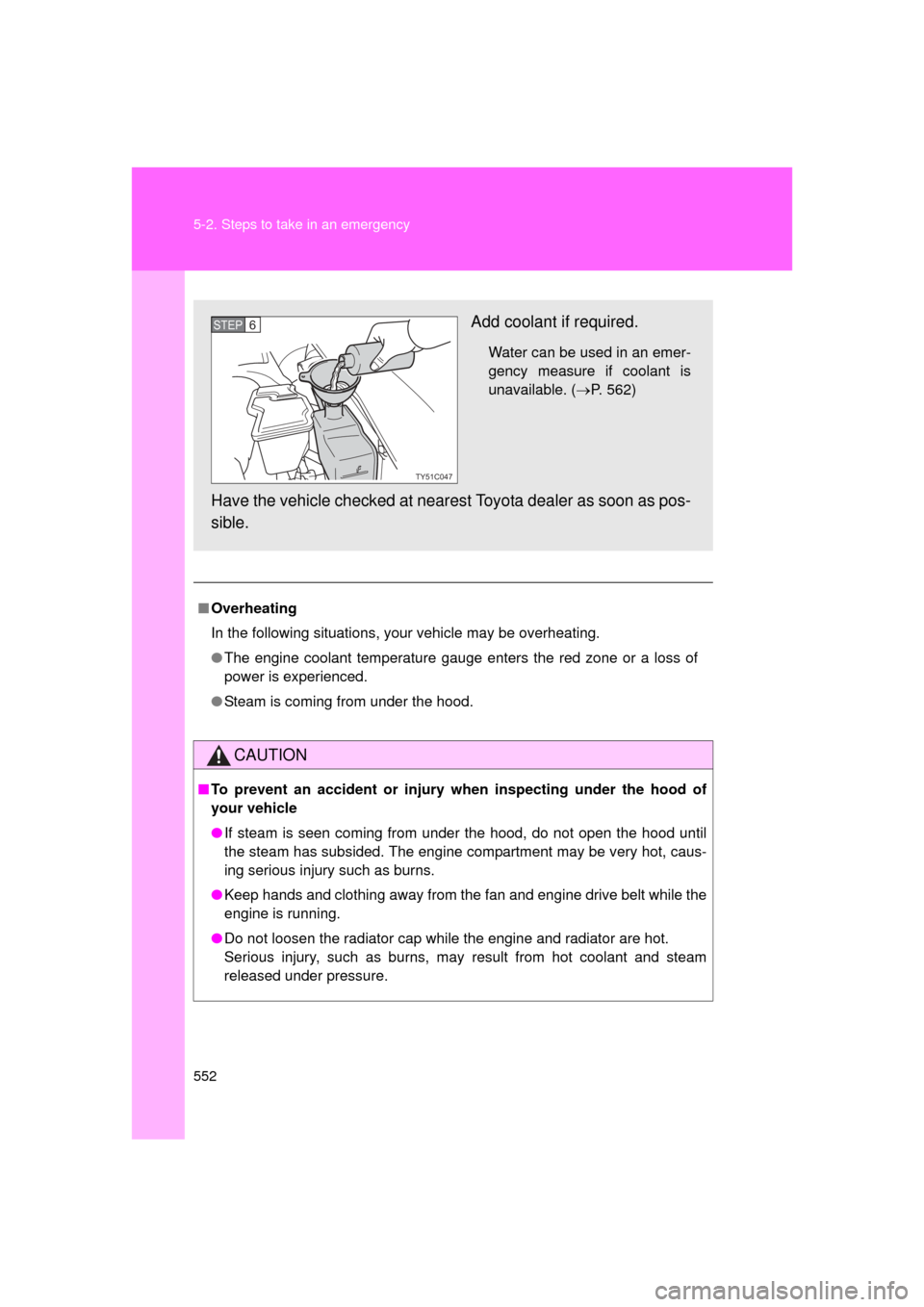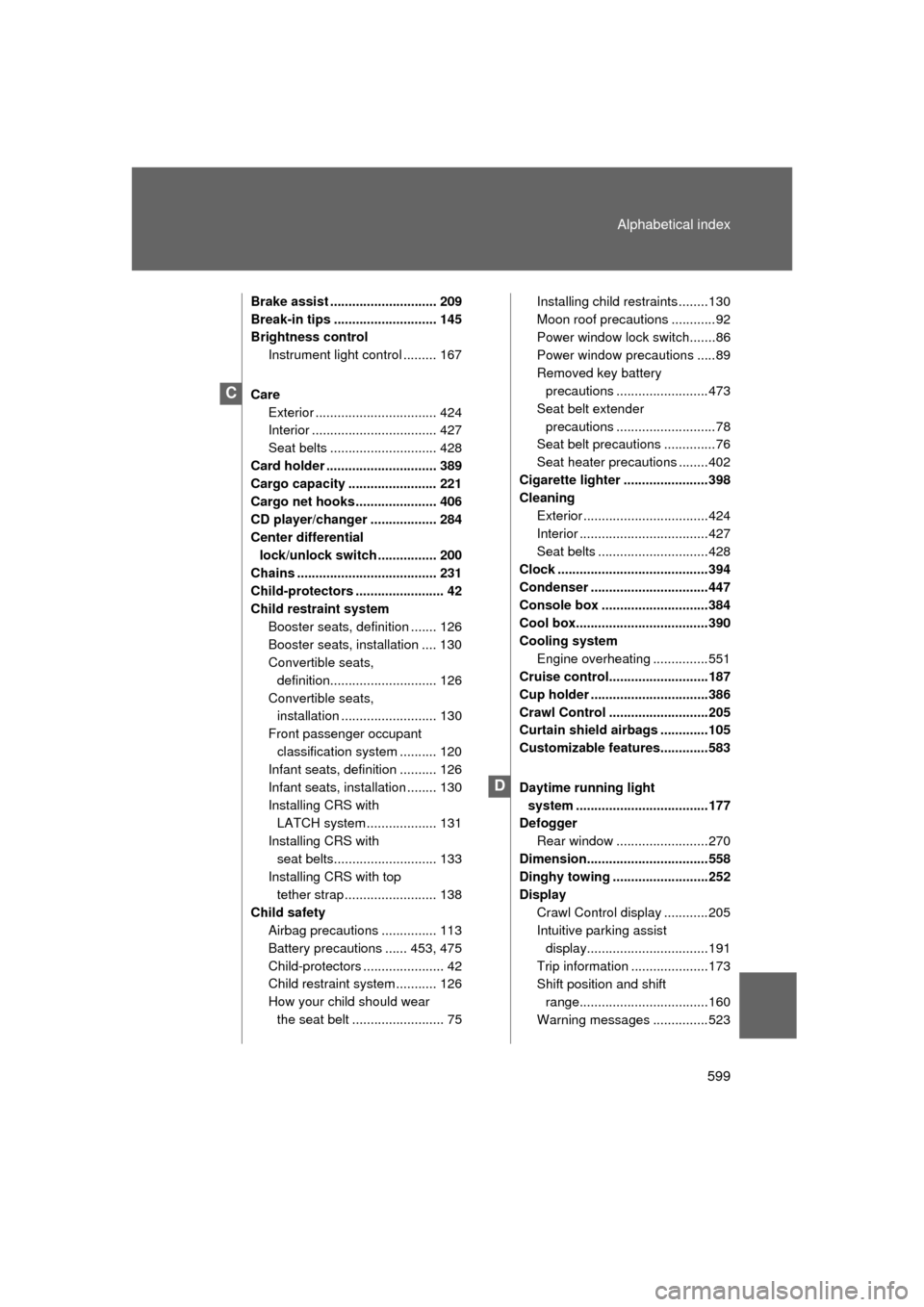Page 150 of 608

150 2-1. Driving procedures
L/C200_U (OM60F74U)
CAUTION
■Exhaust gases
Exhaust gases include harmful carbon monoxide (CO) that is colorless and
odorless. Inhaling exhaust gases may lead to death or a serious health haz-
ard.
● If the vehicle is in a poorly ventilated area, stop the engine. In a closed
area, such as a garage, exhaust gases may collect and enter the vehicle.
This may lead to death or a serious health hazard.
● The exhaust should be checked occasionally. If there is a hole or crack
caused by corrosion, damage to a joint or abnormal exhaust noise, be
sure to have the vehicle inspected and repaired by your Toyota dealer.
Failure to do so may allow exhaust gases to enter the vehicle, resulting in
death or a serious health hazard.
■ When taking a nap in the vehicle
Always turn the engine off. Otherwise, you may accidentally move the shift
lever or depress the accelerator pedal, which could cause an accident or fire
due to engine overheating. Additionally, if the vehicle is parked in a poorly
ventilated area, exhaust gases may collect and enter the vehicle, leadin\
g to
death or a serious health hazard.
Page 164 of 608
164
2-1. Driving procedures
L/C200_U (OM60F74U)
Parking brake
■Usage in winter time
See “Winter driving tips” for parking brake usage in winter time. ( P. 229)
NOTICE
■Before driving
Fully release the parking brake.
Driving the vehicle with the parking brake set will lead to brake components
overheating, which may affect braking performance and increase brake
wear.
Sets the parking brake
Fully set the parking brake
while depressing the brake
pedal.
Releases the parking brake
Slightly raise the lever and
lower it completely while press-
ing the button.
Page 168 of 608
168 2-2. Instrument cluster
L/C200_U (OM60F74U)
NOTICE
■To prevent damage to the engine and its components
● Do not let the indicator needle of the tachometer enter the red zone, which
indicates the maximum engine speed.
● The engine may be overheating if the engine coolant temperature gauge is
in the red zone (“H”). In this case, immediately stop the vehicle in a safe
place, and check the engine after it has cooled completely. ( P. 551)
■ While driving
● When the voltmeter indicates more than 19 V or less than 9 V, the battery
may be malfunctioning. Have your vehicle checked at your Toyota dealer.
● When the engine oil pressure gauge does not work properly, immediately
stop the engine and contact your Toyota dealer.
Page 245 of 608

245
2-5. Driving information
2
When driving
L/C200_U (OM60F74U)
●
Avoid jerky starts or sudden acceleration.
● Avoid jerky steering and sharp turns, and slow down before mak-
ing a turn.
● Note that when making a turn, th e trailer wheels will be closer than
the vehicle wheels to the inside of the turn. Compensate by making
a wider than normal turning radius.
● Slow down before making a turn, in crosswinds, on wet or slippery
surfaces, etc.
Increasing vehicle speed can destabilize the trailer.
● Take care when passing other vehicles. Passing requires consider-
able distance. After passing a vehicle, do not forget the length of
your trailer, and be sure you hav e plenty of room before changing
lanes.
● To maintain engine braking efficiency, when using engine braking,
do not put the transmission in “D”.
Transmission shift range position must be in “5” in the “S” mode.
● Instability happens more frequently when descending steep or long
downhill grades. Before descending, slow down and downshift. Do
not make sudden downshifts while descending steep or long down-
hill grades.
● Avoid holding the brake pedal down too long or applying the
brakes too frequently. This could cause the brakes to overheat and
result in reduced braking efficiency.
● Due to the added load of the trailer, your vehicle’s engine may
overheat on hot days (at temperatures over 85°F [30°C]) when
driving up a long or steep grade. If the engine coolant temperature
gauge indicates overheating, immedi ately turn off the air condition-
ing (if in use), pull your vehicle off the road and stop in a safe spot.
( P. 551)
Page 401 of 608
401
3-7. Other interior features
3
Interior features
L/C200_U (OM60F74U)
Seat heaters
For front seatsFor driver’s seat
Pops the switch out.
For front passenger’s seat
Pops the switch out.
On
The indicator light comes on.
Adjusts the seat tempera-
ture
The further you turn the knob
clockwise, the warmer the seat
becomes.
Raise the knob when you wish to
adjust the seat warmth, and push
the knob back in when finished.
For second seats (if equipped) For left second seat
For right second seat
High heating temperature
Low heating temperature
Off
To turn on the seat heater, press
“HI” or “LO”.
To turn off, press “OFF”.
The indicator light on “HI” or “LO”
switch indicates that the seat
heater is on.
L
R
L
ITY35C016
AUTO
TEMP
OFF TEMP
HI
LOOFF
HI
LO4
12
3
5
4
3
5
ITY35C018
Page 402 of 608

402 3-7. Other interior features
L/C200_U (OM60F74U)
■The seat heaters can be used when
The “ENGINE START STOP” switch is in IGNITION ON mode.
CAUTION
■Burns
● Use caution when seating the following persons in a seat with the seat
heater on to avoid the possibility of burns:
• Babies, small children, the elderly, the sick and the disabled
• Persons with sensitive skin
• Persons who are fatigued
• Persons who have taken alcohol or drugs that induce sleep (sleeping
drugs, cold remedies, etc.)
● Do not cover the seat with anything when using the seat heater.
Using the seat heater with a blanket or cushion increases the temperature
of the seat and may lead to overheating.
● Do not use the seat heater more than necessary. Doing so may cause
minor burns or overheating.
NOTICE
■To prevent seat heater damage
Do not put unevenly weighted objects on the seat and do not stick sharp
objects (needles, nails, etc.) into the seat.
■ To prevent battery discharge
Turn the switches off when the engine is not running.
Page 552 of 608

552 5-2. Steps to take in an emergency
L/C200_U (OM60F74U)
■Overheating
In the following situations, your vehicle may be overheating.
● The engine coolant temperature gauge enters the red zone or a loss of
power is experienced.
● Steam is coming from under the hood.
CAUTION
■To prevent an accident or injury when inspecting under the hood of
your vehicle
● If steam is seen coming from under the hood, do not open the hood until
the steam has subsided. The engine compartment may be very hot, caus-
ing serious injury such as burns.
● Keep hands and clothing away from the fan and engine drive belt while the
engine is running.
● Do not loosen the radiator cap while the engine and radiator are hot.
Serious injury, such as burns, may result from hot coolant and steam
released under pressure.
Add coolant if required.
Water can be used in an emer-
gency measure if coolant is
unavailable. ( P. 562)
Have the vehicle checked at neares t Toyota dealer as soon as pos-
sible.
TY51C047
STEP6
Page 599 of 608

599
Alphabetical index
L/C200_U (OM60F74U)
Brake assist ............................. 209
Break-in tips ............................ 145
Brightness control
Instrument light control ......... 167
Care Exterior ................................. 424
Interior .................................. 427
Seat belts ............................. 428
Card holder .............................. 389
Cargo capacity ........................ 221
Cargo net hooks ...................... 406
CD player/changer .................. 284
Center differential lock/unlock switch ................ 200
Chains ...................................... 231
Child-protectors ........................ 42
Child restraint system Booster seats, definition ....... 126
Booster seats, installation .... 130
Convertible seats, definition............................. 126
Convertible seats, installation .......................... 130
Front passenger occupant classification system .......... 120
Infant seats, definition .......... 126
Infant seats, installation ........ 130
Installing CRS with LATCH system ..... .............. 131
Installing CRS with seat belts............................ 133
Installing CRS with top
tether strap ......................... 138
Child safety Airbag precautions ............... 113
Battery precautions ...... 453, 475
Child-protectors ...................... 42
Child restraint system ........... 126
How your child should wear
the seat belt ......................... 75 Installing child restraints ........130
Moon roof precautions ............92
Power window lock switch.......86
Power window precautions .....89
Removed key battery
precautions .........................473
Seat belt extender precautions ...........................78
Seat belt precautions ..............76
Seat heater precautions ........402
Cigarette lighter .......................398
Cleaning Exterior ..................................424
Interior ...................................427
Seat belts ..............................428
Clock .........................................394
Condenser ................................447
Console box .............................384
Cool box....................................390
Cooling system Engine overheating ...............551
Cruise control...........................187
Cup holder ................................386
Crawl Control ...........................205
Curtain shield airbags .............105
Customizable features.............583
Daytime running light
system ....................................177
Defogger
Rear window .........................270
Dimension.................................558
Dinghy towing ..........................252
Display Crawl Control display ............205
Intuitive parking assist display.................................191
Trip information .....................173
Shift position and shift range...................................160
Warning messages ...............523
C
D